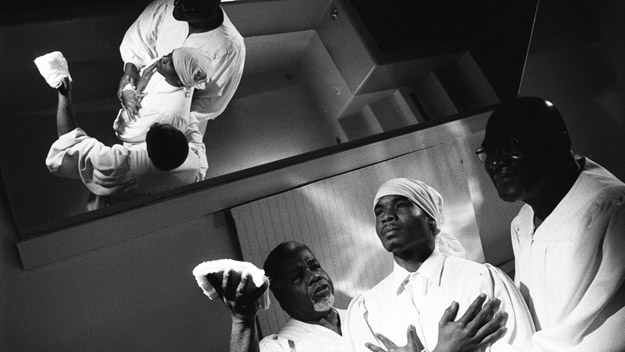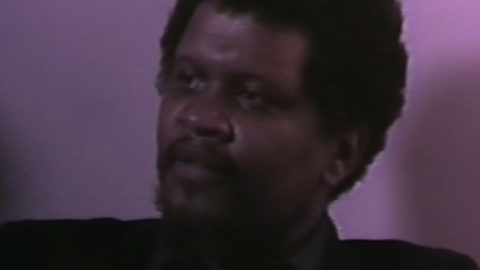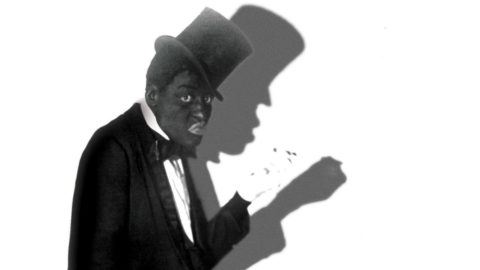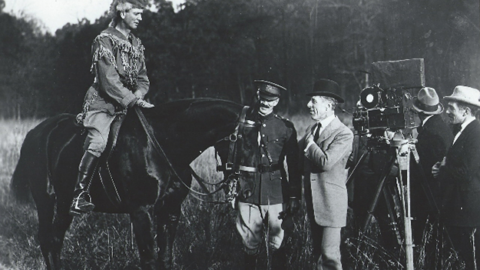Sundance Dispatch: America

America (Garrett Bradley, 2019). Photo by Akasha Rabut. Courtesy of Sundance Institute
In 2014, the Museum of Modern Art restored and unveiled to the public a never-before-seen silent film by Bert Williams, titled Lime Kiln Club Field Day. Made in 1913, the unfinished film had languished in obscurity for 100 years, as had the remarkable circumstances of its production. Lime Kiln Club Field Day featured an all-black cast and an interracial production crew led by a Caribbean director—a historic effort in the early years of the Jim Crow era.
Fascinated by the very existence of this film and the “beautiful depictions of joy and leisure” it captured, filmmaker Garrett Bradley (who won the Sundance Short Film Jury Award in 2017 for her doc short Alone) decided to try and trace the history of Black cinema from Lime Kiln Club Field Day to the present. “Black cinema, first of all, is American cinema—at least in America,” says Bradley as we chat in a crowded lounge in Park City. “It’s a continuous, parallel, simultaneous reality.”
But she also had to contend with the fact that, according to a survey conducted by the Library of Congress, 70 percent of the silent feature films made in America between 1912 and 1929 are missing. “That was the heyday of Black cinema,” says Bradley, speculating that a large part of that 70 percent might have been films made by and for African-American artists.
With her new short America—one of the standout entries in the New Frontier program at this year’s Sundance Film Festival—Bradley attempts to fill those historical gaps using a wholly fascinating mix of archival and documentary strategies. Over the span of 30 gorgeous, black-and-white minutes, she intersperses footage from the Lime Kiln Club Field Day with twelve short films that illustrate a person or event in African-American history that has also become invisible—starting from 1915, when The Birth of a Nation premiered, to 1926, when Bessie Coleman fell from a plane. The images are set to a rich, immersive soundtrack composed by Trevor Mathison, one of the founding members of the Black Audio Film Collective.
“This project is saying, well, what happens if we fill that gap and look at the Bert Williams piece as a starting point, with an indication of how progressive the hundreds of materials that are missing could have been? And if that was the case, it may possibly affect our perception of Black cinema, American cinema,” says Bradley.
To choose stills from Lime Kiln Club Field Day to include in her short, Bradley went through each frame of Bert Williams’ film to find moments that would not be visible to the eye at 17 frames per second. America opens with a series of such images, carefully arranged to build to a specific effect. Bradley first shows us a portrait of Williams, then follows it up with two on-set stills where his face is turned away from the camera. When we see his face again, in the fourth still, he is wearing blackface—while also directing a white crew-member. It’s a dissonant image that drives home the complexity of power relations preserved in these stills, but it’s followed by a picture of pure cheer: Williams and a Black actress riding a merry-go-round, laughing and eating ice-cream.
“What does it means to be able to think about the past and actually have a library of images that are not traumatic? What does it mean to make contemporary iconography that is replacing the trauma of the past?” These are the questions that Bradley says she grappled with while working with the archival material.
Her own shorts—filmed on 35mm and then transferred to video—consist of images both beautiful and provocative: the first one, which marks the release of The Birth of a Nation, explores the simultaneously peaceful and ominous connotations of a white sheet; the next, marking the start of the 40-hour workday in 1916, features young Black Boy Scouts wearing Black Panther hats, framed against an American flag. A later sequence, illustrating the establishment of the Negro National League in 1920, has young baseball players swinging their bats in slow motion, like dancers, against an inky-black backdrop; it’s as if they’re suspended, or maybe embalmed, in time.
Interestingly, each of these moments is recreated by residents of New Orleans, where the film was shot, making America a simultaneous portrait of both the past and the present. In fact, sequences featuring a blacksmith, a horse riding team, and a pastor all feature the real residents of New Orleans going about their daily jobs, capturing certain generational legacies that remain unchanged over time. “This is an illustration of practices that are maybe less visible or less honored. So all of this is a type of documentation as well,” says Bradley.
Much of this attendant historical and production context, however, cannot necessarily be gleaned from the film itself; for viewers without access to press notes or a Q&A, the experience of America might be limited to its images. Bradley says she’s unperturbed by that possibility. “For most of us, our relationship to history is based on an opinion that’s based on an image,” she says.
She named the film strategically, so as to challenge the ways in which American history—and American film history, specifically—is visualized in the cultural imagination. “It gives you an opportunity to penetrate the trauma,” she says, “to replace the images that pop up when you search ‘America’ with new ones.” The film ends on one such hopeful image, taken from Lime Kiln Club Field Day: In the middle of a crowd of jovial performers, a Black actor talks cheerfully with a white actor, his hand affectionately grasping the latter’s arm.
Devika Girish is a freelance film critic. She grew up in India and currently lives in Los Angeles.







